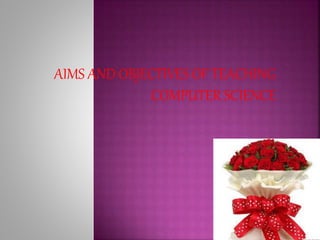Pedagogy of computer
•Als PPTX, PDF herunterladen•
2 gefällt mir•1,181 views
Aim and objective of teaching computer science
Melden
Teilen
Melden
Teilen

Empfohlen
Empfohlen
Weitere ähnliche Inhalte
Was ist angesagt?
Was ist angesagt? (20)
Ähnlich wie Pedagogy of computer
Ähnlich wie Pedagogy of computer (20)
Roles and functions of educational technology in the 21st century

Roles and functions of educational technology in the 21st century
Kürzlich hochgeladen
Mehran University Newsletter is a Quarterly Publication from Public Relations OfficeMehran University Newsletter Vol-X, Issue-I, 2024

Mehran University Newsletter Vol-X, Issue-I, 2024Mehran University of Engineering & Technology, Jamshoro
https://app.box.com/s/7hlvjxjalkrik7fb082xx3jk7xd7liz3TỔNG ÔN TẬP THI VÀO LỚP 10 MÔN TIẾNG ANH NĂM HỌC 2023 - 2024 CÓ ĐÁP ÁN (NGỮ Â...

TỔNG ÔN TẬP THI VÀO LỚP 10 MÔN TIẾNG ANH NĂM HỌC 2023 - 2024 CÓ ĐÁP ÁN (NGỮ Â...Nguyen Thanh Tu Collection
God is a creative God Gen 1:1. All that He created was “good”, could also be translated “beautiful”. God created man in His own image Gen 1:27. Maths helps us discover the beauty that God has created in His world and, in turn, create beautiful designs to serve and enrich the lives of others.
Explore beautiful and ugly buildings. Mathematics helps us create beautiful d...

Explore beautiful and ugly buildings. Mathematics helps us create beautiful d...christianmathematics
Kürzlich hochgeladen (20)
This PowerPoint helps students to consider the concept of infinity.

This PowerPoint helps students to consider the concept of infinity.
TỔNG ÔN TẬP THI VÀO LỚP 10 MÔN TIẾNG ANH NĂM HỌC 2023 - 2024 CÓ ĐÁP ÁN (NGỮ Â...

TỔNG ÔN TẬP THI VÀO LỚP 10 MÔN TIẾNG ANH NĂM HỌC 2023 - 2024 CÓ ĐÁP ÁN (NGỮ Â...
General Principles of Intellectual Property: Concepts of Intellectual Proper...

General Principles of Intellectual Property: Concepts of Intellectual Proper...
Explore beautiful and ugly buildings. Mathematics helps us create beautiful d...

Explore beautiful and ugly buildings. Mathematics helps us create beautiful d...
ICT role in 21st century education and it's challenges.

ICT role in 21st century education and it's challenges.
Mixin Classes in Odoo 17 How to Extend Models Using Mixin Classes

Mixin Classes in Odoo 17 How to Extend Models Using Mixin Classes
Pedagogy of computer
- 1. AIMS AND OBJECTIVES OF TEACHING COMPUTER SCIENCE
- 2. When we study a particular subject,it is essential to think about the motives and purpose of understanding the subject. The merits that can be drawn or purpose that be served by the study of that subject generally become the aims for its study.
- 3. Prior to setting the objectives every teacher should have knowledge of the should have knowledge of the psychological, intellectual and social students. Thus, it can be said that the teaching objectives depend on both the social and environmental factors.
- 4. Generally, the terms aims and objectives are used synonymously. Aim is general declaration of intent which gives direction to a teaching programme. Objective is small objective, helps required in achieving a specific aim which makes that study more useful and helps in bringing the desired bahavioural changes in the students.
- 5. Aim is general declaration of intent which gives direction to a teaching programme. Objective is particular point in that direction. Aim is the answer to the question of why a subject is taught. It is an answer to the question of what will be achieved after the teaching of that topic. They are indefinite and vague Mostly the teacher is responsible for their fulfillment. A lot of time is taken for their achievement. Time taken is not much. The achievement of objectives can be verified along with the teaching of
- 6. To provide practical knowledge of the subject matter. To provide the latest knowledge. To provide the broad objectives of computer sciences i.e, skill knowledge, interest ,appreciation ,application and understanding etc. To provide fundamental skills and processed for proper understanding of the subject matter
- 7. Disciplinary aim- To develop the students in making their minds and habits disciplined. Moral aim-To help the students in the development of moral values such as false notion,superstition and mysteries. Utilization aim-To enables the students to make use of the study of computer sciences in their day –to-day life activites. Vocational aim-To help the students in preparing them for the future professions of occupations.
- 8. Intellectual or mental development aim-TO develop the intellectual or mental abilities of the students. Problem solving aim-To help the students to acquire problem solving ability by training them in scientific method or approach. Social aim-To help in the process of the development of society and inculcate social virtues and ideals among the students. Cultural aim-To help in the process of preservation, promotion and transmission of culture.
- 9. Inter Disciplinary aim-TO help the students in utilizing study of computer sciences for the study of other subjects for the study of other subjects of the school curriculum. Aesthetic aim-To help the students in the inculcation of aesthetic sense and artistic values. Objectives of computer sciences In general, the objectives of teaching are same as those of science or teaching of any other subject. The modern education is known for the all round development of the child as it is child centred.
- 10. Types of Objectives: General Objectives-These objectives pertains to the Computer science as a subject. • Specific objectives-These objectives pertains to a particular topic in a particular time period. these can further be divided into the following categories 1.knowledge 2.Understanding 3. Application 4. Skill/Creativity
- 11. Expected Behavioural Objectives-These objectives indicate the expected behavioural changes that can occur in the students.
- 12. Thank you